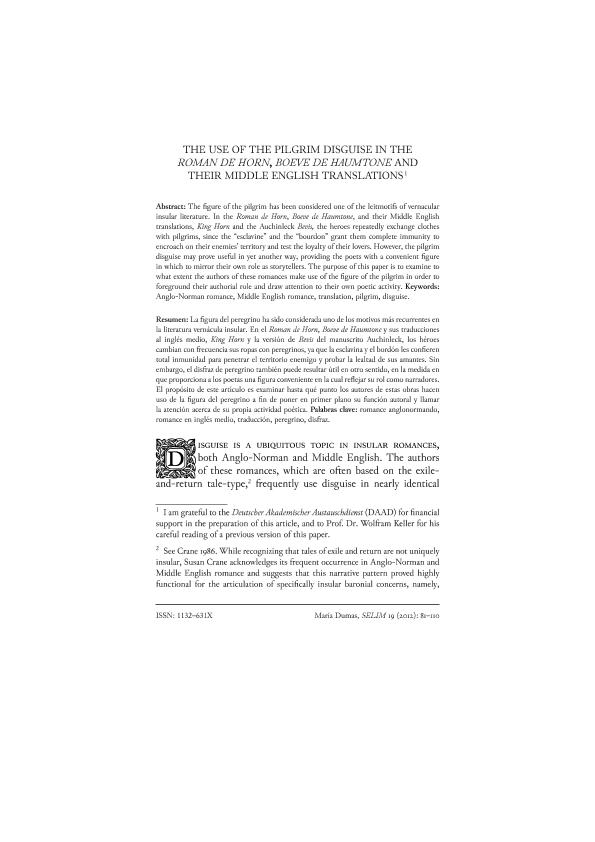Artículo
The figure of the pilgrim has been considered one of the leitmotifs of vernacular insular literature. In the Roman de Horn, Boeve de Haumtone, and their Middle English translations, King Horn and the Auchinleck Bevis, the heroes repeatedly exchange clothes with pilgrims, since the "esclavine" and the "bourdon" grant them complete immunity to encroach on their enemies´ territory and test the loyalty of their lover. However, the pilgrim disguise may prove useful in yet another way, providing the poets with a convenient figure in which to mirror their own role as storytellers. The purpose of this paper is to examine to what extent the authors of these romances make use of the figure of the pilgrim in order to foreground their authorial role and draw attention to their own poetic activity. La figura del peregrino ha sido considerada uno de los motivos más recurrentes en la literatura vernácula insular. En el Roman de Horn, Boeve de Haumtone y sus traducciones al inglés medio, King Horn y la versión de Bevis del manuscrito Auchinleck, los héroes cambian con frecuencia sus ropas con peregrinos, ya que la esclavina y el bordón les confieren total inmunidad para penetrar el territorio enemigo y probar la lealtad de sus amantes. Sin embargo, el disfraz de peregrino también puede resultar útil en otro sentido, en la medida en que proporciona a los poetas una figura conveniente en la cual reflejar su rol como narradores. El propósito de este artículo es examinar hasta qué punto los autores de estas obras hacen uso de la figura del peregrino a fin de poner en primer plano su función autoral y llamar la atención acerca de su propia actividad poética
The use of the pilgrim disguise in the Roman de Horn, Boeve de Haumtone and their Middle English Translations
Fecha de publicación:
07/2012
Editorial:
Sociedad Española de Lengua y Literatura Inglesa Medieval
Revista:
SELIM
ISSN:
1132-631X
e-ISSN:
2792-3878
Idioma:
Inglés
Tipo de recurso:
Artículo publicado
Clasificación temática:
Resumen
Palabras clave:
ANGLO-NORMAN ROMANCE
,
MIDDLE ENGLISH ROMANCE
,
TRANSLATION
,
AUTHOR
Archivos asociados
Licencia
Identificadores
Colecciones
Articulos(IMHICIHU)
Articulos de INST.MULTIDISCIP.DE HISTORIA Y CS.HUMANAS
Articulos de INST.MULTIDISCIP.DE HISTORIA Y CS.HUMANAS
Citación
Dumas, María; The use of the pilgrim disguise in the Roman de Horn, Boeve de Haumtone and their Middle English Translations; Sociedad Española de Lengua y Literatura Inglesa Medieval; SELIM; 19; 7-2012; 81-110
Compartir




